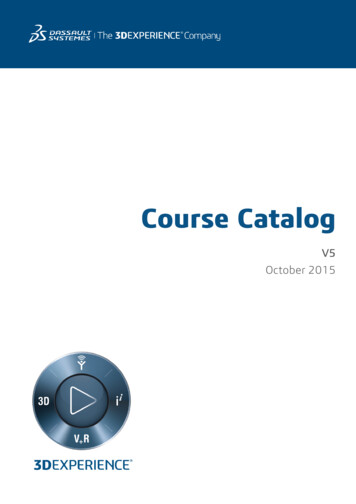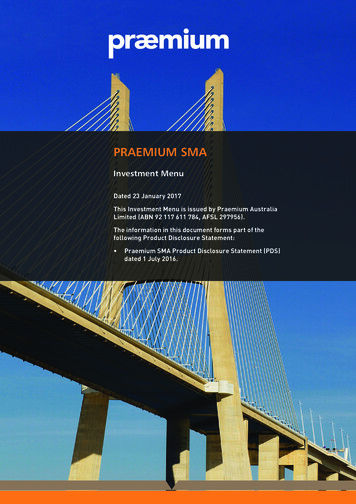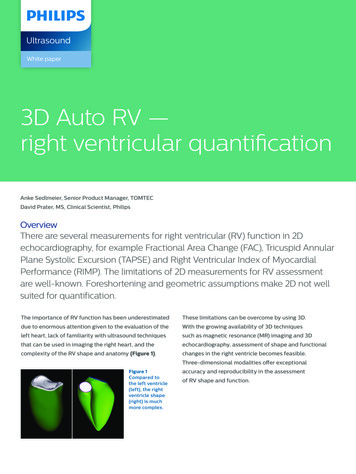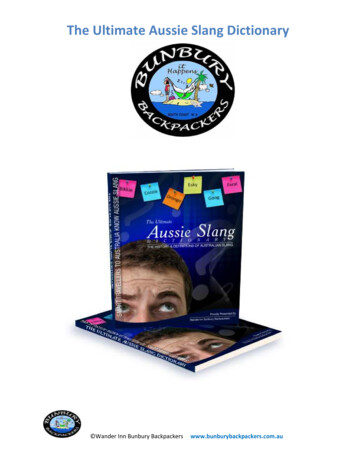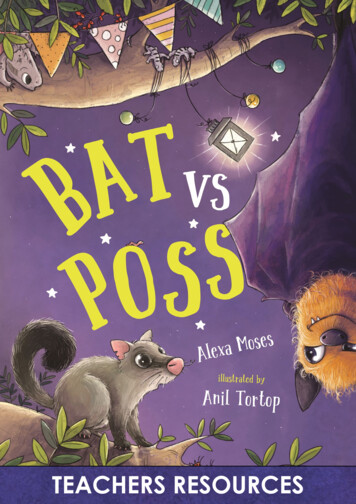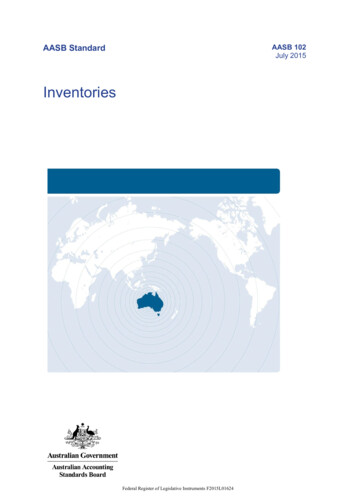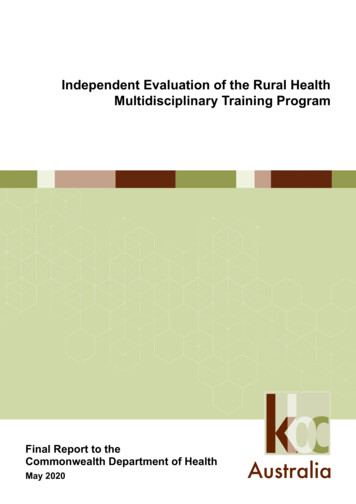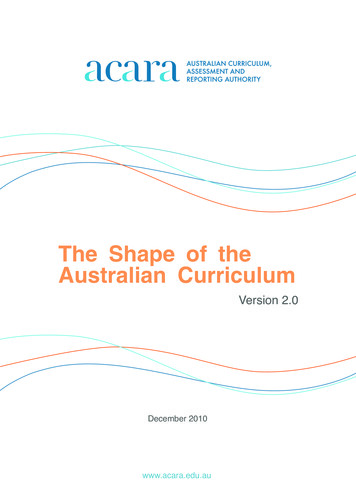
Transcription
November 2010The Shape of theAustralian CurriculumVersion 2.0December 2010www.acara.edu.au
Australian Curriculum, Assessment andReporting Authority 2010The Shape of the Australian Curriculum Version 2.0This work is copyright. You may download,display, print and reproduce this material inunaltered form only (retaining this notice) foryour personal, non-commercial use or use withinyour organisation.All other rights are reserved. Requests andinquiries concerning reproduction and rightsshould be addressed to:iiACARA Copyright Administration, ACARALevel 10, 255 Pitt StreetSydneyNSW 2000
2232526271The Shape of the Australian Curriculum Version 2.01. Purpose2. Preamble3. An Australian CurriculumRationaleGoals of education4. Development of the Australian CurriculumPropositions shaping the Australian CurriculumCurriculum development process5. Scope of the Australian CurriculumThe curriculum across the years of schoolingFoundation Year to Year 2Years 3–8Years 9–10Senior secondary years of schoolingThe diversity of learnersStudents for whom English is another language or dialectStudents with special education needs6. Elements of the Australian CurriculumCurriculum contentLearning area knowledge, skills and understandingGeneral capabilitiesCross-curriculum prioritiesDevelopment of curriculum on a year-by-year orbands-of-school-years basisAchievement standardsA reporting framework – Foundation to Year 107. Teaching, learning, assessing and reporting8. Implementation of the Australian Curriculum9. Quality assurance and review of the Australian Curriculum10. Towards a world-class Australian Curriculum
Amendment historyDateMay 2009October 2010VersionComment1.0Approved by the Interim National Curriculum Boardin May 2009 to guide the development of the first phaseof the Australian Curriculum (English, mathematics,science and history).2.0Updated to support implementation of the Foundationto Year 10 Australian Curriculum for English,mathematics, science and history, to provide the contextfor the next stage of development of the Foundation toYear 12 curriculum and to promote ongoing discussionabout the shape of the Australian Curriculum as awhole.Approved for publication by the ACARA Board 26October 2010 and endorsed by the Ministerial Councilfor Education, Early Childhood Development and YouthAffairs on 8 December 2010.The Shape of the Australian Curriculum Version 2.02
1. Purpose1. The Shape of the Australian Curriculum v2.0 provides the policy background tosupport implementation of the Foundation to Year 10 Australian Curriculum for English,mathematics, science and history. It also provides the context for the next stage ofdevelopment of the Foundation to Year 12 curriculum and will promote ongoing discussionabout the shape of the Australian Curriculum as a whole — what is desired and how thisdiffers from current practice in states and territories.2. The Shape of the Australian Curriculum (May 2009) was written to guide thedevelopment of the first phase of the Australian Curriculum (English, mathematics, scienceand history). It was approved by the Ministerial Council in September 2009.3. A large part of the Shape of the Australian Curriculum v2.0 presents what has beenagreed about the structure and development of the Australian Curriculum, with particularparts clearly indicating matters that require further discussion and debate. The ACARAwebsite provides further information about how feedback can be provided to ACARA onthe Shape of the Australian Curriculum v2.0. This second version of the shape paper willguide the development of the second phase of the Australian Curriculum (geography,languages and the Arts) and will inform the initial work on the rest of the AustralianCurriculum.4. Development of the Australian Curriculum over the next 12 months and discussionabout the Australian Curriculum as a whole will result in the development of a furtherversion of the Shape of the Australian Curriculum towards the end of 2011.The Shape of the Australian Curriculum Version 2.03
2. Preamble5. The Australian Curriculum, Assessment and Reporting Authority (ACARA) isresponsible for: a national curriculum from Foundation to Year 12 in specified learning areas a national assessment program aligned to the national curriculum that measuresstudents’ progress a national data collection and reporting program that supports:— analysis, evaluation, research and resource allocation— analysis, evaluation, research and resource allocation— accountability and reporting on schools— broader national achievement.6. As part of its initial charter, ACARA was asked to commence curriculum developmentfor English, mathematics, science and history. A second phase of work was authorisedinvolving the development of an Australian Curriculum in geography, languages and theArts. Subsequently, Australian education ministers agreed that a third phase of curriculumdevelopment will focus on health and physical education, information and communicationtechnology, design and technology, economics, business, and civics and citizenship.7. The establishment of ACARA can be seen as an outcome of many years of nationalcollaboration in education. Twenty years ago, the Ministerial Council on Education,Employment, Training and Youth Affairs produced a collaborative statement on goals forschooling: the Hobart Declaration of 1989. Both the Hobart Declaration and the 1999Adelaide Declaration authorised and stimulated the national effort.8. The curriculum development work of ACARA is guided by the Melbourne Declarationon Educational Goals for Young Australians, adopted by the Ministerial Council inDecember 2008. The Melbourne Declaration emphasises the importance of knowledge,skills and understanding of learning areas, general capabilities and cross-curriculumpriorities as the basis for a curriculum designed to support 21st century learning.The Shape of the Australian Curriculum Version 2.04
3. An Australian CurriculumRationale9. Education plays a critical role in shaping the lives of the nation’s future citizens. Toplay this role effectively, the intellectual, personal, social and educational needs of youngAustralians must be addressed at a time when ideas about the goals of education arechanging and will continue to evolve.10. At the 60th Australian Education Council meeting held in Hobart in April 1989,education ministers produced a collaborative statement on goals for schooling: the HobartDeclaration. This statement was updated in 1999 as the Adelaide Declaration. In 2008,ministers nominated five major developments that, over the 20-year period, had changedthe ways in which people interacted with each other and thought about the purposes ofschooling. These changes were set out in the Melbourne Declaration on Educational Goals forYoung Australians (see Box 1).Box 1: Changes over the period 1989-2008 with implications for educationGlobal integration and international mobility have increased rapidly in the past decade. As aconsequence, new and exciting opportunities for Australians are emerging. This heightens theneed to nurture an appreciation of, and respect for, social, cultural and religious diversity, anda sense of global citizenship. India, China and other Asian nations are growing and their influence on the world isincreasing. Australians need to become ‘Asia literate’ by building strong relationships withAsia. Globalisation and technological change are placing greater demands on education andskill development in Australia and the nature of jobs available to young Australians ischanging faster than ever. Skilled jobs now dominate jobs growth and people with universityor vocational education and training qualifications fare much better in the employmentmarket than early school-leavers. To maximise their opportunities for healthy, productiveand rewarding futures, Australia’s young people must be encouraged not only to completesecondary education, but also to proceed into further training or education. Complex environmental, social and economic pressures, such as climate change, that extendbeyond national borders pose unprecedented challenges, requiring countries to work togetherin new ways. To meet these challenges, Australians must be able to comprehend and usescientific concepts and principles, and approach problem solving in new and creative ways. Rapid and continuing advances in information and communication technologies (ICT)are changing the ways people share, use, develop and process information and technology,and young people need to be highly skilled in ICT. While schools already employ thesetechnologies in learning, there is a need to increase their effectiveness significantly over thenext decade.Ministerial Council on Education, Employment, Training and Youth Affairs, MelbourneDeclaration on Educational Goals for Young Australians, December 2008, p.13.5The Shape of the Australian Curriculum Version 2.0
3. An Australian Curriculum cont.11. Education must not only respond to these remarkable changes but also, as far aspossible, anticipate the conditions in which young Australians will need to functionas individuals, citizens and workers when they complete their schooling. These futureconditions are distant and difficult to predict. It is expected that almost all young Australianswho begin primary school in 2011 will continue their initial education until 2022. Many willgo on to further education or training through to the mid-2020s and later. Young people willneed a wide and adaptive set of knowledge, understanding and skills to meet the changingexpectations of society and to contribute to the creation of a more productive, sustainableand just society.12. An Australian Curriculum in the 21st century needs to acknowledge the changingways in which young people will learn and the challenges that will continue to shape theirlearning in the future. The curriculum is important in setting out what will be taught, whatstudents need to learn and the expected quality of that learning.13. The commitment to develop a national curriculum reflects a willingness to worktogether, across geographical and school-sector boundaries, to provide a world-classeducation for all young Australians. Working nationally makes it possible to harnesscollective expertise and effort in the pursuit of this common goal. It also offers the potentialof economies of scale and a substantial reduction in the duplication of time, effort andresources.14. The Australian Curriculum also means that all young Australians can learn about thehistories and cultures of Aboriginal and Torres Strait Islander peoples, of their contributionto Australia, and of the consequences of colonial settlement for Indigenous communities,past and present. For Aboriginal people and Torres Strait Islanders, the AustralianCurriculum promotes the importance of pursuing excellence within education settingswhich respect and promote their cultural identity.The Shape of the Australian Curriculum Version 2.06
3. An Australian Curriculum cont.Goals of education15. The Melbourne Declaration commits ‘to supporting all young Australians to becomesuccessful learners, confident and creative individuals, and active and informed citizens’ (seeBox 2) and to promoting equity and excellence in education.Box 2(a): Educational goals for young AustraliansSuccessful learners: develop their capacity to learn and play an active role in their own learning have the essential skills in literacy and numeracy and are creative and productive users oftechnology, especially ICT, as a foundation for success in all learning areas are able to think deeply and logically, and obtain and evaluate evidence in a disciplined way asthe result of studying fundamental disciplines are creative, innovative and resourceful, and are able to solve problems in ways that draw upona range of learning areas and disciplines are able to plan activities independently, collaborate, work in teams and communicate ideas are able to make sense of their world and think about how things have become the way theyare are on a pathway towards continued success in further education, training or employment, andacquire the skills to make informed learning and employment decisions throughout their lives are motivated to reach their full potential.Confident individuals:have a sense of self-worth, self-awareness and personal identity that enables them to managetheir emotional, mental, spiritual and physical wellbeing have a sense of optimism about their lives and the future — are enterprising, show initiativeand use their creative abilities develop personal values and attributes such as honesty, resilience, empathy and respect forothers have the knowledge, skills, understanding and values to establish and maintain healthy,satisfying lives have the confidence and capability to pursue university or post-secondary vocationalqualifications leading to rewarding and productive employment relate well to others and form and maintain healthy relationships are well prepared for their potential life roles as family, community and workforce members embrace opportunities, make rational and informed decisions about their own lives and acceptresponsibility for their own actions.7The Shape of the Australian Curriculum Version 2.0
3. An Australian Curriculum cont.Box 2(b): Educational goals for young AustraliansActive and informed citizens: act with moral and ethical integrity appreciate Australia’s social, cultural, linguistic and religious diversity, and have anunderstanding of Australia’s system of government, history and culture understand and acknowledge the value of Indigenous cultures and possess the knowledge,skills and understanding to contribute to, and benefit from, reconciliation between Indigenousand non-Indigenous Australians are committed to national values of democracy, equity and justice, and participate inAustralia’s civic life are able to relate to and communicate across cultures, especially the cultures and countries ofAsia work for the common good, in particular sustaining and improving natural and socialenvironments are responsible global and local citizens.Ministerial Council on Education, Employment, Training and Youth Affairs, MelbourneDeclaration on Educational Goals for Young Australians, December 2008, p.13.The Shape of the Australian Curriculum Version 2.08
4. Development of the Australian CurriculumPropositions shaping the Australian Curriculum16. The development of the Australian Curriculum is shaped by the following propositions.The Australian Curriculum recognises the entitlement of each student to knowledge,understanding and skills that provide a foundation for successful and lifelong learningand participation in the Australian community. The Australian Curriculum is presented as a continuum that makes clear to teacherswhat is to be taught across the years of schooling. It makes clear to students what theyshould learn and the quality of learning expected of them as they progress throughschool. The Australian Curriculum is based on the assumptions that each student can learn andthe needs of every student are important. It enables high expectations to be set for eachstudent as teachers account for the current levels of learning of individual students andthe different rates at which students develop. The Australian Curriculum is aligned with the Early Years Learning Framework andbuilds on its key learning outcomes, namely: children have a strong sense of identity;children are connected with, and contribute to, their world; children have a strong senseof wellbeing; children are confident and involved learners; and children are effectivecommunicators. The Australian Curriculum helps prepare all young Australians to become competentmembers of the community. It builds firm and meaningful foundation skills as wellas providing the basis for developing expertise for the increasing number of studentswho move on to specialised advanced studies in academic disciplines, professions andtechnical trades. The primary audience for the Australian Curriculum is teachers. The curriculum isconcise and expressed in plain language while preserving a complexity appropriatefor professional practitioners. Consistency in terms of language and broad structuresupports teachers in planning within and across learning areas. The Australian Curriculum specifies what all young Australians should learn as theyprogress through schooling and is designed to be taught well within the overall teachingtime and with the resources available to teachers and students. School authorities makedecisions about the allocation of time and other resources. For some learning areas, the Australian Curriculum will be written with the expectationthat they will be taught in each year of schooling from Foundation to Year 10. For otherareas, the Australian Curriculum will describe an entitlement that students will have theopportunity to learn across Foundation to Year 8, as well as additional learning they maychoose and/or schools may choose to provide in Years 9–10.9The Shape of the Australian Curriculum Version 2.0
4. Development of the Australian Curriculumcont. Jurisdictions, systems and schools will be able to implement the Australian Curriculumin ways that value teachers’ professional knowledge, reflect local contexts and take intoaccount individual students’ family, cultural and community backgrounds. Schools andteachers determine pedagogical and other delivery considerations.The Australian Curriculum is established on a strong evidence base, which is related tolearning, pedagogy and what works in professional practice, and has been benchmarkedagainst international curricula.Curriculum development process17. The process for developing the Australian Curriculum has been designed to generatebroad engagement with, and discussion and feedback about, the shape and content of theAustralian Curriculum.18. It involves four interrelated phases: curriculum shaping, curriculum writing,implementation and curriculum evaluation and review.19. Curriculum shaping involves the development of a paper for each learning area settingout a broad outline of the proposed curriculum. Expert advice is sought in the developmentof an initial draft shape paper released for wide public consultation. Following modificationof the draft in light of consultation and feedback, a final shape paper is published onACARA’s website.20. Curriculum writing involves teams of writers, supported by expert advisory panels andACARA curriculum staff, who draft content descriptions and achievement standards forFoundation to Year 12. The draft Australian Curriculum for each learning area is releasedfor public consultation and is subsequently revised in light of the feedback. The writing stageculminates in publication of the Australian Curriculum for the learning area.The Shape of the Australian Curriculum Version 2.021. Curriculum implementation sees the Australian Curriculum delivered in an onlineenvironment for school authorities, schools and teachers to use. ACARA works with stateand territory curriculum and school authorities to support their ongoing implementationplanning.22. Curriculum evaluation and review processes are put in place to monitor and reviewthe Australian Curriculum based on implementation feedback. The evaluation process mayresult in minor changes to, or a revision of, the curriculum.1023. Major features, processes and broad timeframes for these phases are elaborated in theCurriculum Development Process paper which can be found at www.acara.edu.au. Duringthe first few months of 2011 ACARA will review its process for stakeholder consultation andengagement and will subsequently revise its Curriculum Development process.
5. Scope of the Australian Curriculum24. The Australian Curriculum has been written to take account of the growth anddevelopment of young people across the years of schooling, the diverse needs of the studentpopulation in Australian schools, and the knowledge, understanding and skills all youngAustralians are entitled to learn in terms of learning areas, general capabilities and crosscurriculum priorities.25. The Australian Curriculum makes clear to teachers what is to be taught. It also makesclear to students what they should learn and the quality of learning expected of them.Schools are able to decide how best to deliver the curriculum, drawing on integratedapproaches where appropriate and using pedagogical approaches that account for students’needs, interests and the school and community context. School authorities will be able tooffer curriculum beyond that specified in the Australian Curriculum.The curriculum across the years of schooling26. For some areas the Australian Curriculum has been written with the intention that it istaught to all students in each year of schooling from Foundation to Year 10, with decisionsto be made subsequently about further learning in the senior secondary years. For otherareas the Australian Curriculum will be written for Foundation to Year 12, but with theintention that it is taught to all students across Foundation to Year 8, with subsequentdecisions to be made about further learning in Years 9, 10, 11 and 12.Specific decisions about expected learning and options for further learning will be taken asthe development of the Australian Curriculum proceeds into 2011.Foundation Year to Year 228. In the early years of schooling, children have a natural curiosity about their world andtheir desire to make sense of it provides a platform to construct and review their learningthrough interactions with others, experimentation, scaffolding, explicit teaching, practiceand play in the classroom and beyond. This helps them make sense of a world that is outsidetheir immediate experience, as they connect new knowledge with what they already knowor believe. This also sometimes provides an opportunity to challenge what they know orbelieve.11The Shape of the Australian Curriculum Version 2.027. The Australian Curriculum has been written to focus on an entitlement for all studentswhile acknowledging that the needs and interests of students will vary and the curriculumshould support schools and teachers to respond to these needs and interest. As a result, thecurriculum will articulate what is expected for all students to learn as well as articulatingadditional learning options. Specific decisions about entitlements and opportunities foradditional learning will be taken as the development of the Australian Curriculum proceedsinto 2011.
5. Scope of the Australian Curriculum cont.29. The Australian Curriculum builds on the national Early Years Learning Frameworkand builds on its key learning outcomes, namely: children have a strong sense of identity;children are connected with, and contribute to, their world; children have a strong senseof wellbeing; children are confident and involved learners; and children are effectivecommunicators. The Australian Curriculum is designed to accommodate the varied learningexperiences and diverse backgrounds that children bring to school.30. The Australian Curriculum for students between five and eight years of age (typicallyFoundation to Year 2) recognises the importance of communication, language and buildingrelationships. It gives priority to foundation knowledge, understanding and skills that allchildren are expected to develop to enhance their opportunities for continued learning. Inthese years, priority is given to literacy and numeracy development because these are thefoundations on which further learning is built. The foundation for literacy is built primarilyin English and the foundation for numeracy primarily in mathematics. However, bothliteracy and numeracy must be reinforced and strengthened through learning in othercontexts including science, history, geography and technologies.31. Priority is also given to motor skills development, physical activity and thedevelopment of safe and healthy personal practices through the teaching of health andphysical education. Equally, all students in these early years will have the opportunityto develop their sensory, cognitive and affective appreciation of the world around themthrough exploratory and creative learning. The opportunity to learn a language may also beavailable, subject to school and curriculum authority arrangements.Years 3–8The Shape of the Australian Curriculum Version 2.032. During these years of schooling, students are moving from concrete to abstractthinking. They begin to understand and appreciate different points of view and canconcentrate on tasks for longer periods of time. Their thought processes become morelogical and consistent, and they gradually become more independent as learners. Studentsincreasingly look for and value learning they perceive as relevant, consistent with personalgoals, and/or leading to important outcomes. The transition from primary to secondaryschool coincides with a range of significant physical, cognitive, emotional and socialchanges. Students often begin to question established conventions, practices and values.Their interests extend well beyond their own communities and they develop concerns aboutwider issues.1233. The curriculum for students between eight and 14 years of age (typically Years 3 – 8)is increasingly organised through distinct learning areas and also highlights and promoteslinks between learning areas to deepen knowledge and understanding. While continuing toprioritise English and literacy and mathematics and numeracy, the Australian Curriculumwill deliver a comprehensive education that has children learning in each of the other areasof learning, as outlined in the Melbourne Declaration.
5. Scope of the Australian Curriculum cont.34. While the curriculum focuses on an entitlement for all students, it also describesadditional learning that might be provided in areas such as the arts, humanities and socialsciences, and technologies. In secondary school settings, for example, the curriculumenables schools to build on a broad general education, organised around core learning areas,and to offer opportunities for students to select additional areas of study matched to theirinterests and needs.Specific decisions about entitlements and opportunities for additional learning in particularlearning areas will be taken as the development of the Australian Curriculum proceeds into2011.Years 9–1035. The middle and upper secondary years of schooling can be seen as a period oftransition to adulthood. Students have a clearer sense of their strengths, interests and goals.They begin to see themselves as active players in community life and are often concernedabout major social and environmental issues and the ethical implications of human activityand knowledge.36. In Years 9 and 10, the Australian Curriculum will be written to build on prior learningand deepen understanding in each learning area.37. During the development of the curriculum for these years of schooling considerationwill be given to who will determine what each student will have the opportunity to learn.Such consideration will take account of the opportunities to build on and deepen priorlearning, to broaden learning, including through vocationally-oriented pathways andnational trade cadetships, and to sustain student engagement and improve achievement.39. Flexibility is important because it allows schools to provide learning pathways thatextend the learning entitlement and ensure all students are fully engaged and prepared tocontinue learning into the senior secondary years.13The Shape of the Australian Curriculum Version 2.038. The Australian Curriculum does not make assumptions about how the curriculum willbe delivered in schools. Schools will continue to make decisions about how best to organisestudent learning according to student needs and interests and school and communitycontexts. In some cases, students will commence accredited senior secondary studies(general or vocational in nature) or undertake other programs developed by the school.
5. Scope of the Australian Curriculum cont.Senior secondary years of schooling40. The curriculum for students aged 16 to 18 years of age (typically Years 11 and 12)provides students with increased opportunities to make choices about pathways throughschool and beyond. These choices are informed by previous success and enjoyment, futureoptions for training, learning or employment, and the setting in which the learning is tooccur. Many young people in this age range have already been in part-time employment orwill take up part-time jobs while undertaking their senior secondary schooling. The seniorschool curriculum offers more opportunities for specialisation in learning, including withinthe regular school program and through accredited vocational education and training.The diversity of learners41. Every student is entitled to enriching learning experiences across all areas of thecurriculum. Students in Australian classrooms have multiple, diverse and changing needsthat are shaped by individual learning histories and abilities as well as cultural and languagebackgrounds and socio-economic factors.42. The Australian Curriculum has been developed to ensure that curriculum content andachievement standards establish high expectations for all students. The curriculum providesflexibility for teachers to take into account the different rates at which students with diverselearning needs develop.43. ACARA will work with school authorities to support the implementation of theAustralian Curriculum and will produce advice and guidance about using the curriculum toaddress the diversity of student learning.Students for whom English is another language or dialectThe Shape of the Australian Curriculum Version 2.044. Standard Australian English is essential for success in Australian schools. All
The Shape of the Australian Curriculum Version 2.0 2 Amendment history Date Version Comment May 2009 1.0 Approved by the Interim National Curriculum Board in May 2009 to guide the development of the first phase


